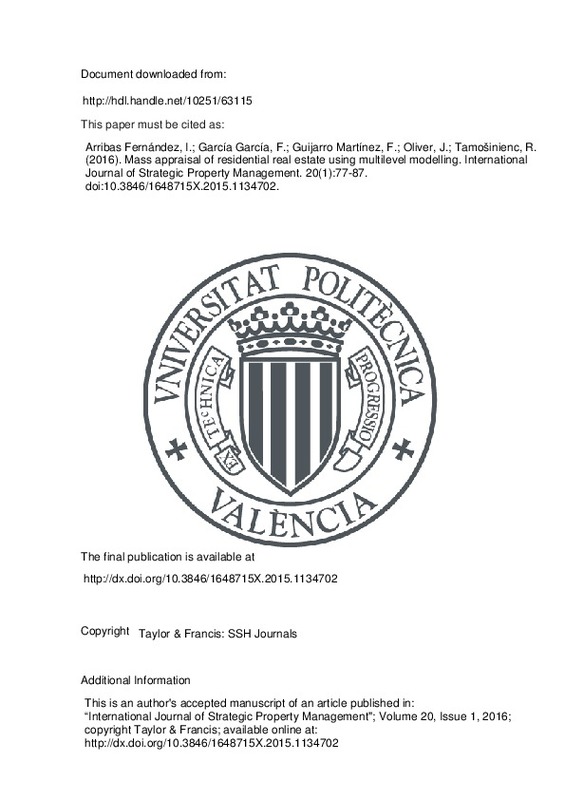JavaScript is disabled for your browser. Some features of this site may not work without it.
Buscar en RiuNet
Listar
Mi cuenta
Estadísticas
Ayuda RiuNet
Admin. UPV
Mass appraisal of residential real estate using multilevel modelling
Mostrar el registro sencillo del ítem
Ficheros en el ítem
| dc.contributor.author | Arribas Fernández, Iván
|
es_ES |
| dc.contributor.author | García García, Fernando
|
es_ES |
| dc.contributor.author | Guijarro Martínez, Francisco
|
es_ES |
| dc.contributor.author | Oliver, Javier
|
es_ES |
| dc.contributor.author | Tamošiūnienė, Rima
|
es_ES |
| dc.date.accessioned | 2016-04-28T14:01:04Z | |
| dc.date.available | 2016-04-28T14:01:04Z | |
| dc.date.issued | 2016-04 | |
| dc.identifier.issn | 1648-715X | |
| dc.identifier.uri | http://hdl.handle.net/10251/63115 | |
| dc.description | This is an author's accepted manuscript of an article published in: “International Journal of Strategic Property Management"; Volume 20, Issue 1, 2016; copyright Taylor & Francis; available online at: http://dx.doi.org/10.3846/1648715X.2015.1134702 | es_ES |
| dc.description.abstract | Mass appraisal, or the automatic valuation of a large number of real estate assets, has attracted the attention of many researchers, who have mainly approached this issue employing traditional econometric models such as Ordinary Least Squares (OLS). However, this method does not consider the hierarchical structure of the data and therefore assumes the unrealistic hypothesis of the independence of the individuals in the sample. This paper proposes the use of the Hierarchical Linear Model (HLM) to overcome this limitation. The HLM also gives valuable information on the percentage of the variance error caused by each level in the hierarchical model. In this study HLM was applied to a large dataset of 2,149 apartments, which included 17 variables belonging to two hierarchical levels: apartment and neighbourhood. The model obtained high goodness of fit and all the estimated variances of the parameters in HLM were lower than those calculated by OLS. It can be concluded as well that no further neighbourhood variables need be added to the model to improve the goodness of fit, since almost all the residual variance can be attributed to the first hierarchical level of the model, the apartment level. | es_ES |
| dc.language | Inglés | es_ES |
| dc.publisher | Taylor & Francis: SSH Journals | es_ES |
| dc.relation.ispartof | International Journal of Strategic Property Management | es_ES |
| dc.rights | Reserva de todos los derechos | es_ES |
| dc.subject | Housing market | es_ES |
| dc.subject | Price modelling | es_ES |
| dc.subject | Mass appraisal | es_ES |
| dc.subject | Hierarchical linear model | es_ES |
| dc.subject | Real estate | es_ES |
| dc.subject.classification | ECONOMIA FINANCIERA Y CONTABILIDAD | es_ES |
| dc.title | Mass appraisal of residential real estate using multilevel modelling | es_ES |
| dc.type | Artículo | es_ES |
| dc.identifier.doi | 10.3846/1648715X.2015.1134702 | |
| dc.rights.accessRights | Abierto | es_ES |
| dc.contributor.affiliation | Universitat Politècnica de València. Departamento de Economía y Ciencias Sociales - Departament d'Economia i Ciències Socials | es_ES |
| dc.description.bibliographicCitation | Arribas Fernández, I.; García García, F.; Guijarro Martínez, F.; Oliver, J.; Tamošiūnienė, R. (2016). Mass appraisal of residential real estate using multilevel modelling. International Journal of Strategic Property Management. 20(1):77-87. doi:10.3846/1648715X.2015.1134702 | es_ES |
| dc.description.accrualMethod | S | es_ES |
| dc.relation.publisherversion | http://dx.doi.org/10.3846/1648715X.2015.1134702 | es_ES |
| dc.description.upvformatpinicio | 77 | es_ES |
| dc.description.upvformatpfin | 87 | es_ES |
| dc.type.version | info:eu-repo/semantics/publishedVersion | es_ES |
| dc.description.volume | 20 | es_ES |
| dc.description.issue | 1 | es_ES |
| dc.relation.senia | 304574 | es_ES |
| dc.identifier.eissn | 1648-9179 |







![[Cerrado]](/themes/UPV/images/candado.png)

